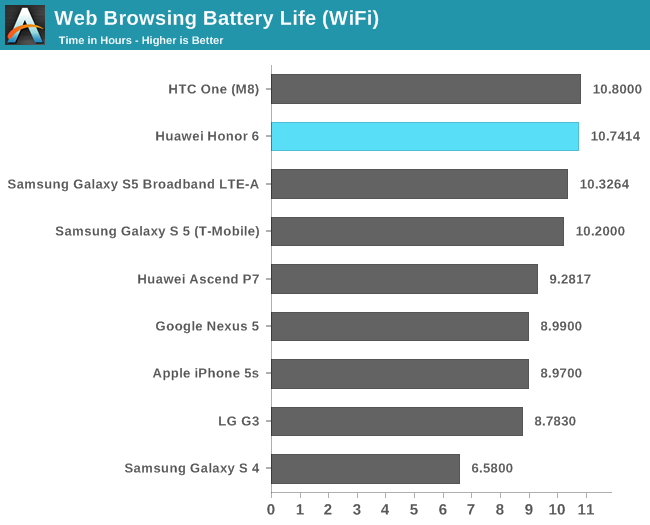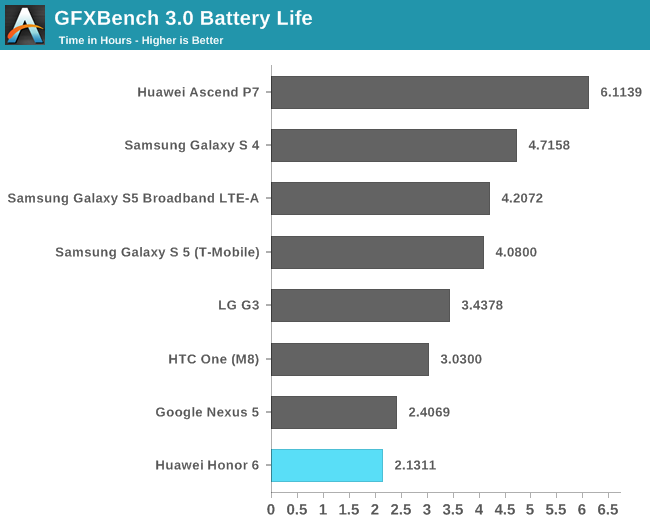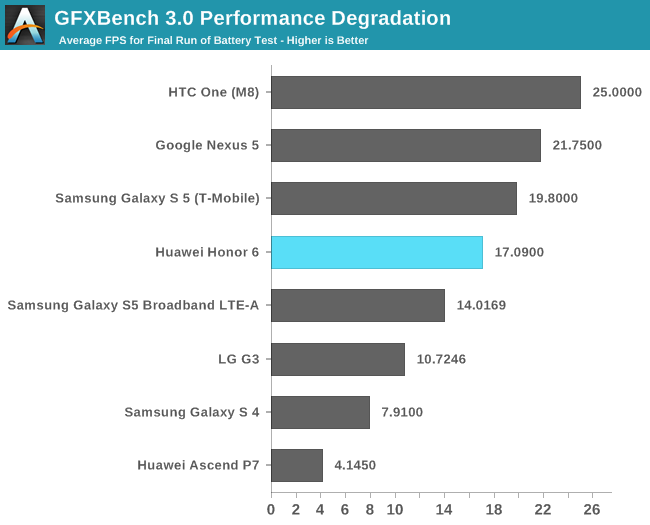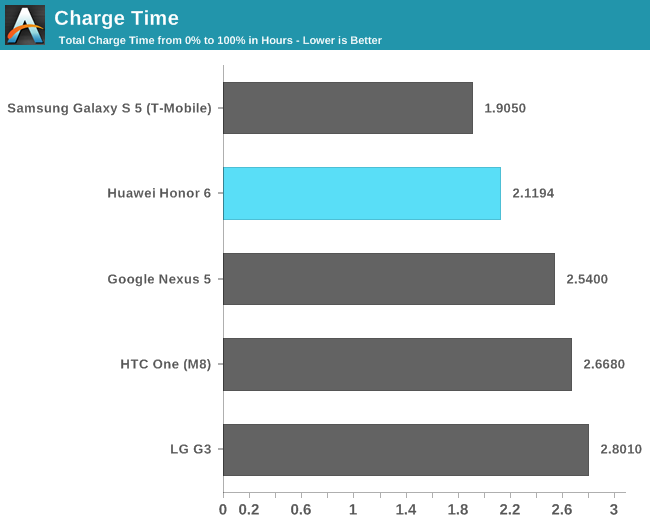Huawei Honor 6 Review
by Andrei Frumusanu & Joshua Ho on September 12, 2014 9:00 AM EST- Posted in
- Smartphones
- Huawei
- Android
- Mobile
- Honor 6
Remark on Benchmark Cheating
Last year, I uncovered some of Samsung’s habits in manipulating benchmark applications by tweaking SoC DVFS parameters and tipped off Brian who went on to publicize what ended up being a embarrassment for many vendors. We hoped this would discourage vendors from continuing the practice, and indeed, since then we’ve seen some improvement as Samsung, for example, has abandoned all tampering with benchmark applications. Josh recently pointed out at Huawei’s practices on the Ascend P7 and made it clear that Huawei wasn’t deterred from playing dirty. For the Honor 6, we see the same behavior.
You might ask yourself why I only mention this in the battery section as we already took a look at benchmark score of device. In the case of the Honor 6, Huawei doesn’t allow any higher DVFS states or enables additional cores for benchmark runs, but instead takes advantage of the kernel’s HMP parameters to try to improve scores. I already mentioned that setting the performance profile to “optimal performance” does little in actual gains and adversely affects battery life. While that profile uses threshold values of 75% up and 25% down, versus Smart’s (rightfully) conservative 90% up and 50% down, Huawei’s “optimization mechanism” automatically detects benchmarks and lowers these down to 30%/15%. The effect is that you might gain about half to a full frame per second in 3D benchmarks and a bit of a boost in CPU-spiky loads such as the 3DMark physics test. On the other hand, you completely and utterly destroy big.LITTLE’s power management scheme. This is especially visible in GFXBench's battery test where, if ran with the cheating mechanism in place, would drop the battery scores down by a staggering 20%.
I was a bit shocked at this because what Huawei has done here is detrimental and not worth the small boost in benchmark scores. I found that the mechanism detected all current popular benchmarking applications, but there's one extra addition I was baffled by: Chrome. Huawei forcefully sets the HMP parameters inside of Google's Chrome browser to equal the "Performance" profile in the battery settings, even if you have it set to the "Smart" profile. More intriguing is that the stock browser is not affected by this and retains the set parameters that the user chooses. We see this as a targeted attempt in trying to manipulate our (and other site's) benchmarking suites inside the browser as Chrome is chosen as an apples-to-apples environment for web tests.
In the end, it sadly seems that the only way to deter OEMs of including such mechanisms and avoid benchmark manipulation is to continue to having to report on it. Huawei's attempt is, bluntly said, just stupid, as they achieve nothing more than handicapping themselves in battery benchmarks.
As this article is also a SoC evaluation piece where we look into the technical aspect of the device, all benchmark tests were run without being affected by the cheating mechnaism.
Battery life
While performing all battery tests we normalize the brightness of all devices at 200cd/m² to be able to compensate for display power discrepancies.

The Honor 6 lasted 10.7h on the Wi-Fi web-browsing test, which places itself quite competetively among other flagships such as the Galaxy S5 or HTC One M8. When you consider the device's 3000mAh battery which has a 200mAh advantage over the S5 and 400mAh advantage over the M8, then it ends up less efficient. The M8 is especially a good comparison device as it has the same size 5" 1080p screen, yet the Huawei Honor 6 only manages to trail it while having a 15% advantage in battery capacity.

BaseMark OS II's battery test is mainly CPU loading, and due to Huawei/HiSilicon's lack of a power budgeting driver for the Kirin 920 we see one of the lowest battery scores we've ever seen in recent smartphones. The Cortex A15's are simply running wild without any power limitations other than thermal limits. Of course you'd be hard to find any kind of real-world use-case where an application would load the device to such figures.
Anand had argued for 2+4 designs as "optimal" for big.LITTLE, where we would have only 2 big cores available in a SoC; I don't necessarily agree with that, as beyond the cost and increased die size of the chips there is no negative impact on the end-device. Cores can always be turned off, but can't be added. That theory does not work though when the software stack fails, and therein we see big.LITTLE's greatest weakness. The above graph is a perfect illustration of the impact that a misconfigured big.LITTLE SoC can have on a device.

The GFXBench T-Rex battery test also the puts the Honor 6 among the bottom of current generation devices. Again, we go back to the platform power consumption figures to make sense of it: As theorized, the Mali T628 has roughtly half the perf/W of the Adreno 330 when normalizing for the same performance. The fact that the A15 cores are being fired up at all in GFXBench's very light CPU load doesn't do it any favor in terms of power.

I'd like to mention that the "Battery Performance" chart we've used until now has been renamed to "Performance Degradation" to better describe what it represents as I've seen instances where people would confuse our chart with GFXBench's own "Long term performance" figure. The difference being that we measure the performance on the last run while GFXBench averages for the whole duration of the battery test.
The Honor 6 here behaves well in comparison to other devices. It's able to maintain its instantaneous 17fps performance figure until the end of the battery test. I think this is due the phone having quite good thermal dissipation charateristics. This also ties in with the bad battery life figure, the GPU doesn't throttle much if at all. I did extract the device's thermal policies, and we see that the GPU is only throttled in the second thermal throttling state, which is enacted when a sensor passes 47°C. I wasn't able to determine exactly which sensor this is, but it does not seem to be located on the SoC silicon as there we can see temperatures rise up to 75°C. Huawei running its thermal policy on an external sensor may also explain the lack of much thermal throttling on the device, as its dissipation is adequate enough that it never gets enacted very often.
Battery Charging
Integrated in its body, we find an embedded 3000mAh battery running a 3.85V chemistry. The actual capacity is a little bit higher as the typical figure is mentioned at 3100mAh. I also could see that the fuel-gauge has a capacity tracking mechanism, for this unit I saw it measure a value of 3050mAh. This is definitely a useful feature to have for tracking battery degradation. Many OEMs nowdays prefer to implement voltage tracking fuel-gauges as they are simpler and cheaper to implement, this is definitely a plus in favor of HiSilicon's own charger IC.

The device comes with a 5.0V 2.0A charger delivered. I didn't have any plug converter available to use the US style plug on the supplied charger so I used one of Samsung's 2.0A chargers. I could see no sign of any kind proprietary signalling and the device's drivers setup a charging rate of around 1750mA.
In the charging graph we can see where the device switches from its full charge rate to trickle-charging, which is around 80% of capacity or at the 75 minute charging mark. The power input from that point on steadily lowers itself in three stages until it reaches only about of 150mA of input current.

From zero to 100% the phone charges in a little over 2 hours, a pretty good figure for a phone with an embedded battery of its size.










59 Comments
View All Comments
DIYEyal - Saturday, September 13, 2014 - link
I found a typo in the battery life page: "I think this is due the phone having quite good thermal dissipation charateristics ."akshayprbhu - Friday, October 10, 2014 - link
that is not a typo. The phone is having good thermal dissipation as it is cooler than similar spec phones when a performance test was done! Youtube for more proof...lilmoe - Saturday, September 13, 2014 - link
Great review of what really matters. I especially liked the in-depth analysis of the SoC and its platform power in comparison to others. Looking forward to future reviews."Ideally, it would be interesting to see a 720p mode on 1440p screens as it would offer perfect scaling, with one logical pixel being mapped to exactly four physical ones, without the need for interpolation and upscaling artifacts"
If Samsung ever decides to put a 1440p panel on the GS6, I seriously hope they allow a 720p mode in their power saving options. Even if pentile, It would be MUCH sharper than any other 720p AMOLED panel since it's up-scaled. Actually, I seriously interested to see how it would look like. Plus, the added performance and battery life would be legendary on a phone faster and more efficient than the current GS5. Totally intriguing.
lilmoe - Saturday, September 13, 2014 - link
Oh, this is just a suggestion. If you must use browser benchmarks to measure platform performance (sighs...), wouldn't it be better to use the stock browser since it's what most people use? You know, since the stock browser is usually more optimized for that specific device and generally performs better than Chrome. Using Chrome to see the difference of Android devices in comparison is OK since they'd be using the same browser running on the same OS, but definitely NOT OK in comparison with other platforms.Please correct me if I'm wrong, because I'm positive that I'm not.
aryonoco - Sunday, September 14, 2014 - link
Thanks for the great review, this was the first time that any publication has exposed the inner workings of a Hisilicon SoC, and you've done a great job of that. However I wanted to mention here that I strongly disagree with your analysis of the software.Designing software that's going to be used by mass users is a constant balancing act between exposing enough power to satisfy different user requirements and power users, and yet keeping the UI simple enough so that the vast majority of users are not overwhelmed by the array of features. The Permission Management feature here, similar to those baked into many custom ROMs goes well over the line and is a huge user experience disaster. To ship an OEM ROM with this, is begging for a deluge of support calls from clueless customers who have disabled things and then wonder why their phone doesn't work as intended.
I'm not saying that the current permission management scenario in Android is perfect, far from it. I don't think anyone has figured out the perfect balance of how to inform users about third party apps without scaring them, turning the notices meaningless, or overwhelming users.
One of Anand's greatest assets was his ability to articulate his vision of good UI in various products. Him and Brian could explain why certain choices were made (for example in terms of treatment of external storage on Android, or the design tradeoffs about non-replaceable batteries) and the guiding principles behind them. File managers are archaic and confusing to 90% of users. I know the tech-savvy AT readership will disagree, but the whole concept of files and directories are broken for average users, especially on a device like a phone, and they are better off being abstracted away from them. Your comments on file managers in KitKat, or your praise of Huawei's software "enhancements" shows a lack of understanding of where the line is when it comes to UX design.
I hope that now that Anand is gone, AT doesn't become a place where the writers are blind to the needs of average customers. We do not need Android to regress to the wild days of Gingerbread, or worse, Windows Mobile.
Ethos Evoss - Sunday, September 14, 2014 - link
Well, you complaining about huawei logo or writing missing and main thing is that you NEVER complained on iphones that they NEVER put writing on their phones but that is alright ? h ? people are so pathetic .. if apple wud make soome plastic dick sticking out from phone you guys would say that is fine bcos it is iphone and we will forgive that we will get used to it .. oohh jeezz naive peopleakshayprbhu - Friday, October 10, 2014 - link
the writings are a part of the mandatory regulations to denote the compliance with the telecom regulations. and it does not eat up too much space on the back.darkich - Sunday, September 14, 2014 - link
Absolutely great analysis. Andrei and Joshua, keep these top notch write ups coming!SeleniumGlow - Monday, September 15, 2014 - link
I was hoping that the Kirin processor would have a comparison with the MediaTek MT6592. But I guess there are some obvious differences in the Big Little implementation that will prevent it from being a good comparison.siberstorm - Monday, September 15, 2014 - link
The mediocre camera and obvious cutrate shoddiness (wtf the stabilization is just the 1080p field cut down to 720p with none of the rest of the sensor used, so ghetto) is unacceptable and this goes for the mate 7 as well. So bye bye huawei. I am still interested in the lenovo vibe z2 pro aka k920 and would love a review of that phone, but the chances of lenovo sending one to anandtech are slim, considering they arent gunning for the global market like huawei is.